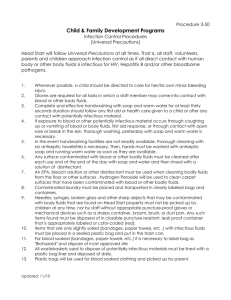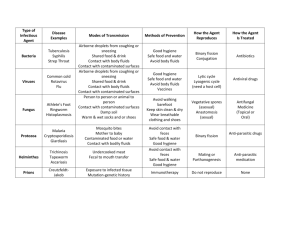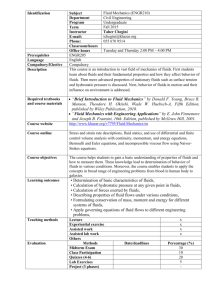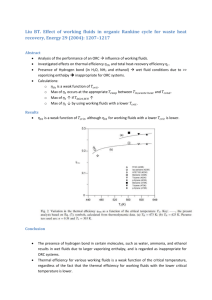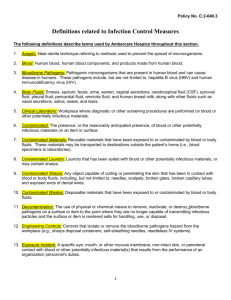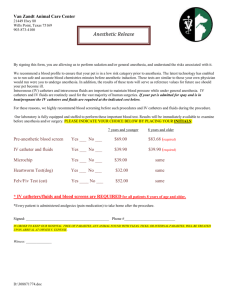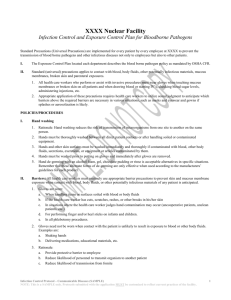Rule Student Bloodborne Pathogen Exposure
advertisement
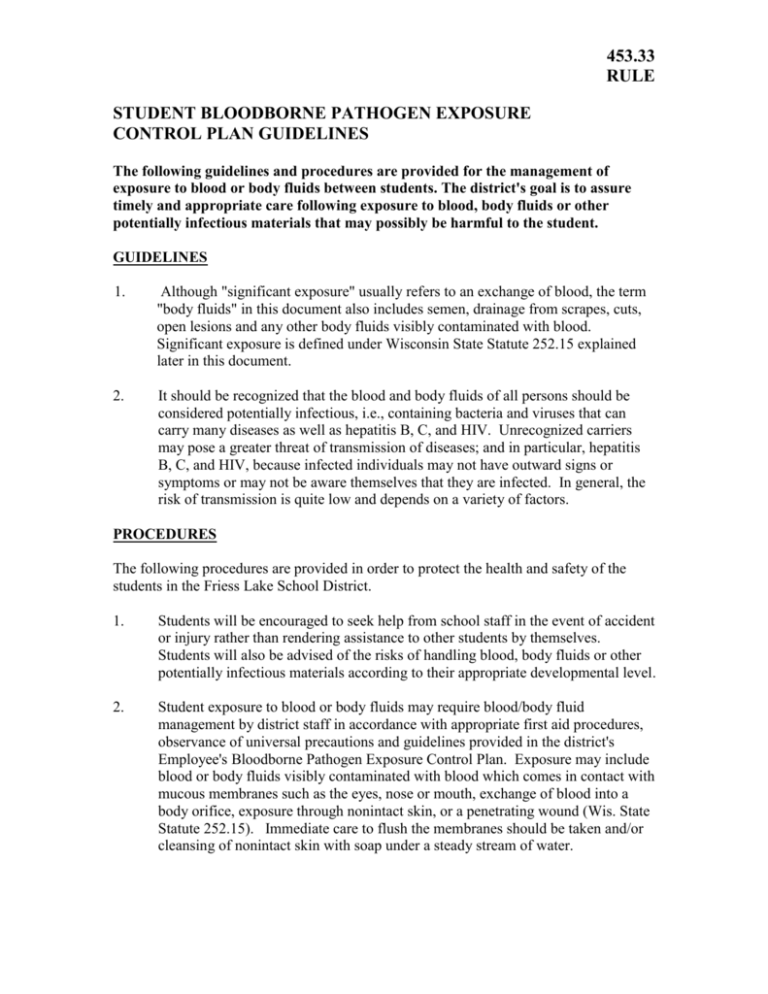
453.33 RULE STUDENT BLOODBORNE PATHOGEN EXPOSURE CONTROL PLAN GUIDELINES The following guidelines and procedures are provided for the management of exposure to blood or body fluids between students. The district's goal is to assure timely and appropriate care following exposure to blood, body fluids or other potentially infectious materials that may possibly be harmful to the student. GUIDELINES 1. Although "significant exposure" usually refers to an exchange of blood, the term "body fluids" in this document also includes semen, drainage from scrapes, cuts, open lesions and any other body fluids visibly contaminated with blood. Significant exposure is defined under Wisconsin State Statute 252.15 explained later in this document. 2. It should be recognized that the blood and body fluids of all persons should be considered potentially infectious, i.e., containing bacteria and viruses that can carry many diseases as well as hepatitis B, C, and HIV. Unrecognized carriers may pose a greater threat of transmission of diseases; and in particular, hepatitis B, C, and HIV, because infected individuals may not have outward signs or symptoms or may not be aware themselves that they are infected. In general, the risk of transmission is quite low and depends on a variety of factors. PROCEDURES The following procedures are provided in order to protect the health and safety of the students in the Friess Lake School District. 1. Students will be encouraged to seek help from school staff in the event of accident or injury rather than rendering assistance to other students by themselves. Students will also be advised of the risks of handling blood, body fluids or other potentially infectious materials according to their appropriate developmental level. 2. Student exposure to blood or body fluids may require blood/body fluid management by district staff in accordance with appropriate first aid procedures, observance of universal precautions and guidelines provided in the district's Employee's Bloodborne Pathogen Exposure Control Plan. Exposure may include blood or body fluids visibly contaminated with blood which comes in contact with mucous membranes such as the eyes, nose or mouth, exchange of blood into a body orifice, exposure through nonintact skin, or a penetrating wound (Wis. State Statute 252.15). Immediate care to flush the membranes should be taken and/or cleansing of nonintact skin with soap under a steady stream of water. 453.33 (2) RULE Exposure to saliva, such as spitting, does not constitute exposure unless the saliva or other body fluid is visibly contaminated with blood and the conditions of exposure have occurred as defined elsewhere. Blood soaked clothing needs to be removed by the student, whenever possible, and placed in a labeled, leak proof plastic bag for transport. The parent, guardian or adult student is responsible for laundering soiled garments. REPORTING 1. A student who is exposed to blood or body fluids with visible blood will immediately inform appropriate school personnel. This would typically be the student's teacher who would then inform the principal or his/her designee. The building administrator or designee has final determination of the action and referrals that will be made. 2. In the event of a significant exposure incident, the administrator or designee will notify the parent or guardian as soon as possible within the school day or within 24 hours of the incident. It is not the responsibility of the principal or designee to provide medical information regarding the risks of exposure. The parent/guardian will be referred to the physician for further evaluation. The decision to proceed with a medical evaluation or follow-up for a student is the responsibility of the parent, guardian or adult student and is also their financial responsibility. 3. A Student's Report of Exposure to Blood/Body Fluids (Exhibit A) is to be filed with the district's Business Office within 48 hours and a Determination of Exposure to Blood/Body Fluids report (Exhibit B) provided to the parent/guardian or adult student for physician/agency follow-up. A report is required for both an injured student and the student who has otherwise come in contact with blood or body fluids visibly contaminated with blood. 4. Even though an incident or injury has not been identified as a significant exposure, a notation must be entered in the School Reporting Manual using the Daily School Health Log form (Exhibit C). 5. Guidelines for sporting events will fall under WIAA guidelines (Exhibit D). EDUCATION The district health curriculum will reflect the student's responsibility in protecting themselves from exposure to blood, body fluids and other potentially infectious materials according to appropriate developmental level. OASD staff will promote awareness regarding district policy and management of exposure to blood and body fluids between students. 453.33 (3) RULE Under Wisconsin Statutes 252.15 "significantly exposed" means sustained a contact which carries a potential for a transmission of HIV, by one or more of the following: 1. Transmission into a body orifice or onto mucous membrane of blood; semen; vaginal secretions; cerebrospinal, synovial, pleural, peritoneal, pericardial or amniotic fluid; or other body fluid that is visibly contaminated with blood. 2. Exchange during the accidental or intentional infliction of a penetrating wound, including a needle puncture, of blood; semen; vaginal secretions; cerebrospinal, synovial, pleural, peritoneal, pericardial or amniotic fluid; or other body fluid that is visibly contaminated with blood. 3. Exchange, into an eye, an open wound, an oozing lesion, or where a significant breakdown in the epidermal barrier has occurred, of blood; semen; vaginal secretions; cerebrospinal, synovial, pleural, peritoneal, pericardial or amniotic fluid; or other body fluid that is visibly contaminated with blood. This definition refers to an exposure that carries the potential for transmission of HIV (AIDS virus). Since other infectious diseases such as hepatitis can also be transmitted by significant exposure to blood or other body fluids, the Student's Report of Exposure to Blood/Body Fluids (Exhibit A) should be completed to document such a possibility. CROSS-REFERENCE: 526 Employee Bloodborne Pathogen Exposure Control Plan Approved: July 31, 2003 FRIESS LAKE SCHOOL DISTRICT Hubertus, Wisconsin
